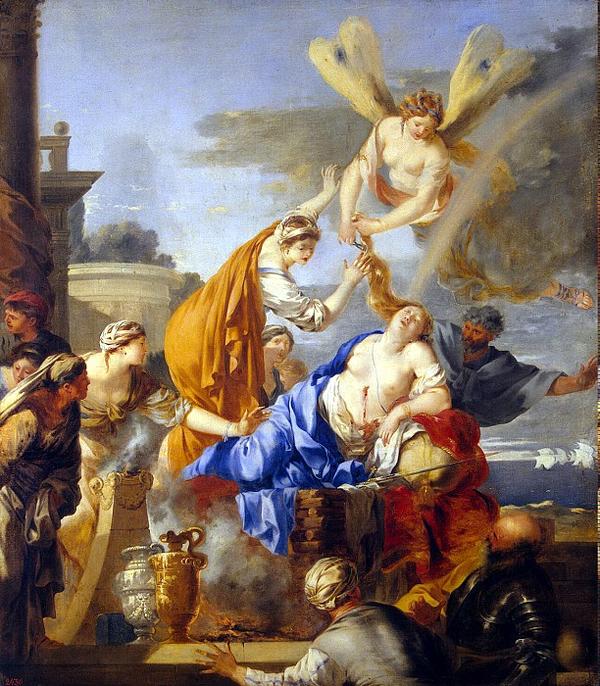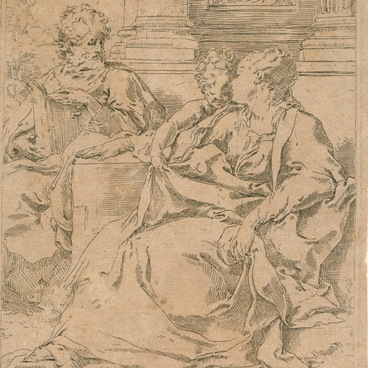The Holy Family with Saint Elizabeth
Creation period
circa 1642
Dimensions
10,2x11,2 cm
Technique
etching, second condition out of three
Collection
1
Open in app#1
Sebastien Bourdon
The Holy Family with Saint Elizabeth
#3
#2
The Holy Family is one of the later Christian subjects and it is hardly mentioned in the canonical Gospels. Iconography and most of the stories were created in the early Middle Ages — the IV-VI centuries — when the apocryphal gospels of the childhood appeared — the Gospel of Pseudo-Matthew and the ‘Arab Gospel of the Savior’s Childhood’. Both were written under the influence of the Proto-Gospel of Jacob, created after 160 AD, but the little Jesus performed more miracles in them — he tamed the wild beasts and dragons, crushed idols and moved the palm tree to the Garden of Paradise.
On occasion, the venerable St. Elizabeth and John the Baptist, her husband Zacharias as well as Anne (the mother of the Virgin Mary), were depicted as secondary characters together with the main members of the Holy Family.
The main subject of the work is the flight of the Virgin Mary with the baby Jesus and her husband Joseph the Betrothed to Egypt from the perfidies of Herod and their return to Nazareth after the death of the king. On the way to and from Egypt the Holy Family visited several places, which are now revered by Christians. In one of versions of the story the Virgin Mary, Jesus and Joseph stopped, on their way from Egypt, at the home of Virgin Mary’s cousin — St. Elizabeth who was the mother of John Baptist. She too fled from Bethlehem’s massacre of the innocents. Sebastien Bourdon used this plot for his etching “The Holy Family with St. Elizabeth”. The Virgin Mary with a noticeably grown-up Jesus, halos on their heads, are depicted in the center of the sheet. St. Elizabeth and St. Joseph the Betrothed are standing on their sides. Little John the Baptist is not on the engraving.
On occasion, the venerable St. Elizabeth and John the Baptist, her husband Zacharias as well as Anne (the mother of the Virgin Mary), were depicted as secondary characters together with the main members of the Holy Family.
The main subject of the work is the flight of the Virgin Mary with the baby Jesus and her husband Joseph the Betrothed to Egypt from the perfidies of Herod and their return to Nazareth after the death of the king. On the way to and from Egypt the Holy Family visited several places, which are now revered by Christians. In one of versions of the story the Virgin Mary, Jesus and Joseph stopped, on their way from Egypt, at the home of Virgin Mary’s cousin — St. Elizabeth who was the mother of John Baptist. She too fled from Bethlehem’s massacre of the innocents. Sebastien Bourdon used this plot for his etching “The Holy Family with St. Elizabeth”. The Virgin Mary with a noticeably grown-up Jesus, halos on their heads, are depicted in the center of the sheet. St. Elizabeth and St. Joseph the Betrothed are standing on their sides. Little John the Baptist is not on the engraving.
#5
The French painter and graphic artist Sebastien Bourdon was born in 1616 in Montpellier into the family of Protestant Marene Bourdon, a stained glass master. Sebastien left for Paris at a very young age to study in the studio of the artist Bertel. Some biographers mention the fact that, at the age of 14, he created frescoes in one of the castles near Bordeaux. In 1634, after a failure in military service, Bourdon arrived in Rome. He found new teachers and idols there — Pieter van Laer, Nicolas Poussin, Castiglione and others. His paintings sold well, but the artist had to leave Rome when he received threats that his adherence to Protestantism would be made public.
When Bourdon returned to Paris, his paintings became more spacious and full of air. The artist began to highlight the background, adding more vivid tones and gradations, like in the painting “The Death of Dido”, for example.
When Bourdon returned to Paris, his paintings became more spacious and full of air. The artist began to highlight the background, adding more vivid tones and gradations, like in the painting “The Death of Dido”, for example.
#6
Sebastien Bourdon. The Death of Dido. Canvas, oil, 1644.
img via: commons.wikimedia.org
img via: commons.wikimedia.org
In 1648, Bourdon and his colleagues founded the Royal Academy of Arts and Sculpture; in 1652 he became the court painter of the Queen Christina of Sweden. Two years later the artist returned to Paris, where he spent the rest of his life. The master worked extensively on landscapes — paintings and engravings — in his final years. Sebastien Bourdon died in 1671 and was buried in the suburbs of Saint-Germain.
read morehide
00:00
00:00
1x
The Holy Family with Saint Elizabeth
Creation period
circa 1642
Dimensions
10,2x11,2 cm
Technique
etching, second condition out of three
Collection
1
Open in app
Share




